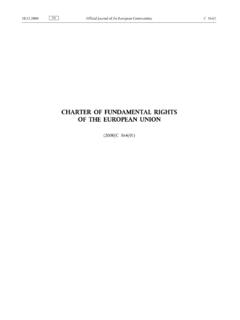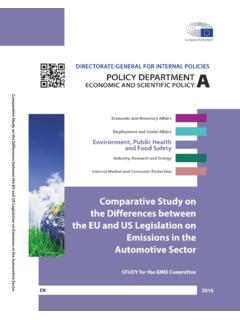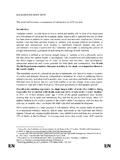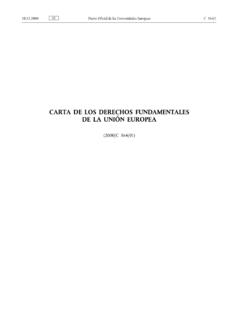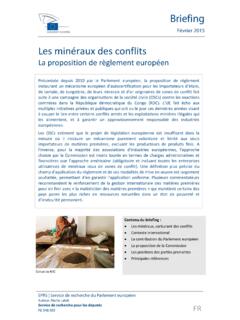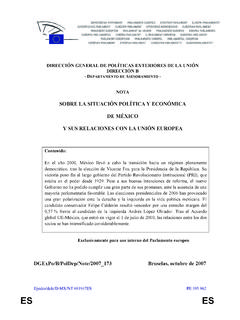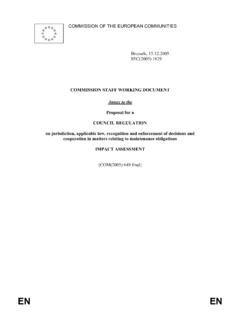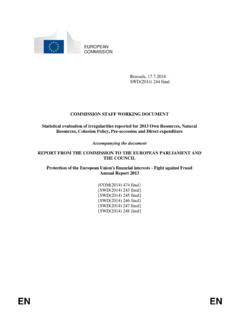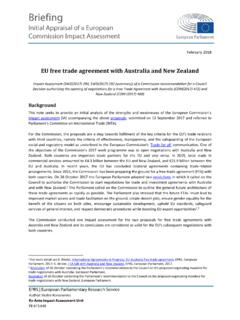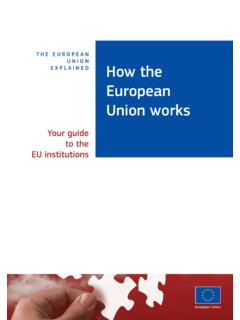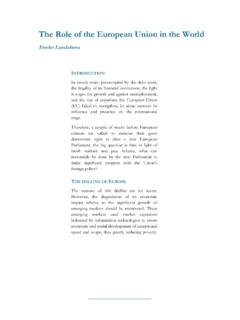Transcription of The historical development of European integration
1 EN - 18/06/2018 FACT SHEETS ON THE European UNIONThe historical developmentof European integrationPE The First Developments up to the Single European The Maastricht and Amsterdam The treaty of Nice and the Convention on the Future of The treaty of THE PUBLICATIONThis leaflet contains a compilation of Fact Sheets provided by Parliament s PolicyDepartments and Economic Governance Support Unit on the relevant policy Fact Sheets are updated regularly and published on the website of the EuropeanParliament: THE PUBLISHERA uthor of the publication: European ParliamentDepartment responsible: Unit for Coordination of Editorial and CommunicationActivitiesE-mail: completed in June, 2018 European union , 2018 DISCLAIMERThe opinions expressed in this document are the sole responsibility of the author anddo not necessarily represent the official position of the European and translation for non-commercial purposes are authorised, providedthe source is acknowledged and the publisher is given prior notice and sent a Sheets on the European union - 18/06/201831 - THE FIRST TREATIES - [ ]The disastrous effects of the Second World War and the constant threat of an East-West confrontation meant that the Franco-German reconciliation had become a toppriority.
2 The decision to pool the coal and steel industries of six European countries,brought into force by the treaty of Paris in 1951, marked the first step towardsEuropean integration . The Treaties of Rome of 1957 strengthened the foundationsof this integration and the notion of a common future for the six European BASIS The treaty establishing the European Coal and Steel Community (ECSC), orTreaty of Paris, was signed on 18 April 1951 and came into force on 25 July the first time, six European States agreed to work towards integration . ThisTreaty laid the foundations of the Community by setting up an executive known asthe High Authority , a Parliamentary Assembly, a Council of Ministers, a Court ofJustice and a Consultative Committee. The ECSC treaty expired on 23 July 2002at the end of the 50-year validity period laid down in its Article 97. In accordancewith the Protocol (No 37) annexed to the Treaties (the treaty on European Unionand the treaty on the Functioning of the European union ), the net worth of theECSC s assets at the time of its dissolution was assigned to the Research Fundfor Coal and Steel to finance research by Member States in sectors relating to thecoal and steel industry.
3 The Treaties establishing the European Economic Community (EEC) and theEuropean Atomic Energy Community (EAEC, otherwise known as Euratom ), orthe Treaties of Rome, were signed on 25 March 1957 and came into force on1 January 1958. Unlike the ECSC treaty , the Treaties of Rome were concluded for an unlimited period (Article 240 of the EEC treaty and Article 208 of the EAECT reaty), which conferred quasi-constitutional status on them. The six founding countries were Belgium, France, Germany, Italy, Luxembourgand the The founders of the ECSC were clear about their intentions for the treaty , namelythat it was merely the first step towards a European Federation . The commoncoal and steel market was to be an experiment which could gradually be extendedto other economic spheres, culminating in a political Europe. The aim of the European Economic Community was to establish a common marketbased on the four freedoms of movement (goods, persons, capital and services).
4 The aim of Euratom was to coordinate the supply of fissile materials and theresearch programmes initiated or being prepared by Member States on thepeaceful use of nuclear energy. The preambles to the three Treaties reveal a unity of purpose behind the creationof the Communities, namely the conviction that the States of Europe must workFact Sheets on the European union - 18/06/20184together to build a common future as this alone will enable them to control PRINCIPLESThe European Communities (the ECSC, EEC and Euratom) were born of the desire fora united Europe, an idea which gradually took shape as a direct response to the eventsthat had shattered the continent. In the wake of the Second World War the strategicindustries, in particular the steel industry, needed reorganising. The future of Europe,threatened by East-West confrontation, lay in Franco-German appeal made by Robert Schuman, the French Foreign Minister, on 9 May1950 can be regarded as the starting point for European integration .
5 At that time,the choice of coal and steel was highly symbolic: in the early 1950s coal and steelwere vital industries, the basis of a country s power. In addition to the clear economicbenefits, the pooling of French and German resources was intended to mark the endof the rivalry between the two countries. On 9 May 1950 Robert Schuman declared: Europe will not be made all at once, or according to a single plan. It will be builtthrough concrete achievements which first create a de facto solidarity.' It was on thebasis of that principle that France, Italy, Germany and the Benelux countries (Belgium,the Netherlands and Luxembourg) signed the treaty of Paris, which concentratedpredominantly on ensuring: free movement of goods and free access to sources of production; permanent monitoring of the market to avoid distortions which could lead to theintroduction of production quotas; compliance with the rules of competition and the principle of price transparency; support for modernisation and conversion of the coal and steel the signing of the treaty , and despite France being opposed to thereestablishment of a German national military force, Ren Pleven was giving thoughtto the formation of a European army.
6 The European Defence Community (EDC),negotiated in 1952, was to have been accompanied by a Political Community (EPC).Both plans were shelved following the French National Assembly s refusal to ratify thetreaty on 30 August to get the process of European integration under way again following thefailure of the EDC took the form of specific proposals at the Messina Conference (inJune 1955) on a customs union and atomic energy. They culminated in the signing ofthe EEC and EAEC EEC treaty s provisions included: the elimination of customs duties between Member States; the establishment of an external Common Customs Tariff; the introduction of common policies for agriculture and transport; the creation of a European Social Fund; the establishment of a European Investment Bank; the development of closer relations between the Member Sheets on the European union - 18/06/20185To achieve these objectives the EEC treaty laid down guiding principles and set theframework for the legislative activities of the Community institutions.
7 These involvedcommon policies: the common agricultural policy (Articles 38 to 43), transport policy(Articles 74 and 75) and a common commercial policy (Articles 110 to 113).The common market is intended to guarantee the free movement of goods and themobility of factors of production (the free movement of workers and enterprises, thefreedom to provide services and the free movement of capital). Euratom treaty had originally set highly ambitious objectives, includingthe speedy establishment and growth of nuclear industries . However, owing to thecomplex and sensitive nature of the nuclear sector, which touched on the vital interestsof the Member States (defence and national independence), those ambitions had tobe scaled Convention on certain institutions common to the European Communities,which was signed and entered into force at the same time as the Treaties of Rome,stipulated that the Parliamentary Assembly and Court of Justice would be commoninstitutions.
8 All that remained was for the Executives to be merged; the Treatyestablishing a Single Council and a Single Commission of the European Communitiesof 8 April 1965, known as the Merger treaty , duly completed the process of unifyingthe then on, the EEC held sway over the sectoral communities, the ECSC and theEAEC. This amounted to a victory for the general EEC system over the coexistence oforganisations with sectoral competence, and a victory for its Novak05/2018 Fact Sheets on the European union - 18/06/201862 - DEVELOPMENTS UP TO THESINGLE European ACT - [ ]The main developments of the early Treaties are related to the creation of Communityown resources, the reinforcement of the budgetary powers of Parliament, electionof MEPs by direct universal suffrage and the setting-up of the European MonetarySystem. The entry into force of the Single European Act in 1986, substantially alteringthe treaty of Rome, bolstered the notion of integration by creating a large ACHIEVEMENTS IN THE FIRST STAGE OF INTEGRATIONA rticle 8 of the treaty of Rome provided for the completion of a common market over atransitional period of 12 years, in three stages, ending on 31 December 1969.
9 Its firstaim, the customs union , was completed more quickly than expected. The transitionalperiod for enlarging quotas and phasing out internal customs ended as early as 1 July1968. Even so, at the end of the transitional period there were still major obstacles tofreedom of movement. By then, Europe had adopted a common external tariff for tradewith third a Green Europe was another major project for European integration . The firstregulations on the common agricultural policy (CAP) were adopted and the EuropeanAgricultural Guidance and Guarantee Fund (EAGGF) was set up in treaty to the institutionsThe first institutional change came about with the Merger treaty of 8 April 1965, whichmerged the executive bodies. This took effect in 1967, setting up a single Counciland Commission of the European Communities (the ECSC, EEC and EAEC) andintroducing the principle of a single resources and budgetary powersThe Council decision of 21 April 1970 set up a system of Community own resources,replacing financial contributions by the Member States ( ).
10 The treaty of Luxembourg of 22 April 1970 granted Parliament certain budgetarypowers ( ). The treaty of Brussels of 22 July 1975 gave Parliament the right to reject thebudget and to grant the Commission a discharge for implementing the budget. Thesame treaty set up the Court of Auditors, a body responsible for scrutinising theCommunity s accounts and financial management ( ). Act of 20 September 1976 gave Parliament new legitimacy and authority byintroducing election by direct universal suffrage ( ). The Act was revised in 2002,introducing the general principle of proportional representation and other frameworkprovisions for national legislation on the European Sheets on the European union - 18/06 UK joined on 1 January 1973, together with Denmark and Ireland; the Norwegianpeople had voted against accession in a referendum. Greece became a member in1981; Portugal and Spain joined in budgetAfter the first round of enlargement there were calls for greater budgetary rigourand reform of the CAP.
